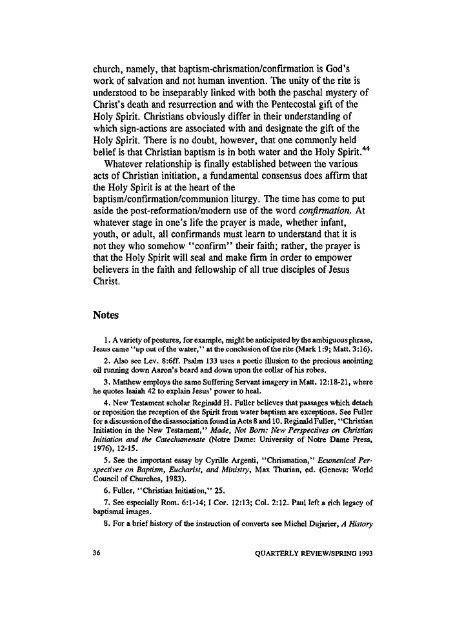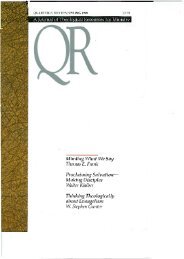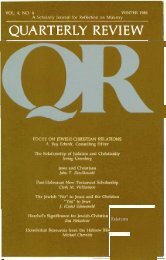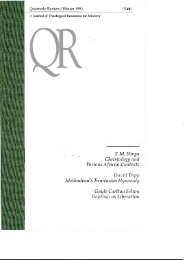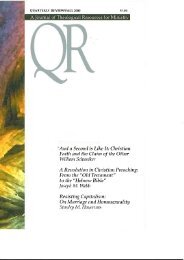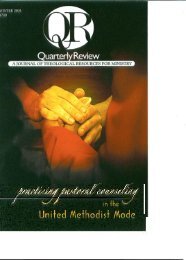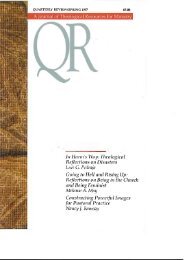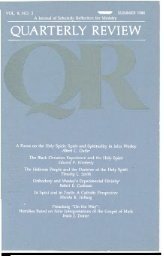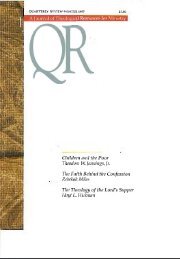TJieodore W. Jennings, Jr. The Meaning of ... - Quarterly Review
TJieodore W. Jennings, Jr. The Meaning of ... - Quarterly Review
TJieodore W. Jennings, Jr. The Meaning of ... - Quarterly Review
Create successful ePaper yourself
Turn your PDF publications into a flip-book with our unique Google optimized e-Paper software.
church, namely, thatbaptism-chrismation/confirmation is God's<br />
work <strong>of</strong> salvation and not human invention. <strong>The</strong> unity <strong>of</strong> the rite is<br />
understood to be inseparably linked with both the paschal mystery <strong>of</strong><br />
Christ's death and resurrection and with the Pentecostal gift <strong>of</strong> the<br />
Holy Spirit. Christians obviously differ in their understanding <strong>of</strong><br />
which sign-actions are associated with and designate the gift <strong>of</strong> the<br />
Holy Spirit. <strong>The</strong>re is no doubt, however, that one commonly held<br />
belief is that Christian baptism is in both water and the Holy Spirit. 44<br />
Whatever relationship is finally established between the various<br />
acts <strong>of</strong> Christian initiation, a fundamental consensus does affirm that<br />
the Holy Spirit is at the heart <strong>of</strong> the<br />
baptism/confirmation/communion liturgy. <strong>The</strong> time has come to put<br />
aside the post-reformation/modern use <strong>of</strong> the word confirmation. At<br />
whatever stage in one's life the prayer is made, whether infant,<br />
youth, or adult, all confirmands must learn to understand that it is<br />
not they who somehow "confirm" their faith; rather, the prayer is<br />
that the Holy Spirit will seal and make firm in order to empower<br />
believers in the faith and fellowship <strong>of</strong> all true disciples <strong>of</strong> Jesus<br />
Christ.<br />
Notes<br />
1. A variety <strong>of</strong> postures, for example, might be anticipated by the ambiguous phrase,<br />
Jesus came **up out <strong>of</strong> the water,** at the conclusion <strong>of</strong> the rite (Mark 1:9; Matt. 3:16).<br />
2. Also see Lev. 8:6ff. Psalm 133 uses a poetic iUusion to the precious anointing<br />
oil running down Aaron's beard and down upon the coUar <strong>of</strong> his robes.<br />
3. Matthew employs the same Suffering Servant imagery in Matt. 12:18-21, where<br />
he quotes Isaiah 42 to explain Jesus* power to heal.<br />
4. New Testament scholar Reginald H. Fuller believes that passages which detach<br />
or reposition the reception <strong>of</strong> the Spirit from water baptism are exceptions. See Fuller<br />
for adiscussion <strong>of</strong> the disassociation found in Acts 8 and 10. Reginald Fuller, * 'Christian<br />
Initiation in the New Testament," Made, Not Bom: New Perspectives on Christian<br />
Initiation and the Catechumenate (Notre Dame: University <strong>of</strong> Notre Dame Press,<br />
1976), 12-15.<br />
5. See the important essay by Cyrille Argenti, "Chrismation,*' Ecumenical Perspectives<br />
on Baptism, Eucliarist, and Ministry, Max Thurian, ed. (Geneva: World<br />
Council <strong>of</strong> Churches, 1983).<br />
6. FuUer, "Christian Initiation," 25,<br />
7. See especially Rom. 6:1-14; I Cor. 12:13; Col. 2:12. Paul left a rich legacy <strong>of</strong><br />
baptismal images.<br />
8. For a brief history <strong>of</strong> the instruction <strong>of</strong> converts see Michel Dujarier, A History<br />
36 QUARTERLY REVIEW/SPRINO 1993


